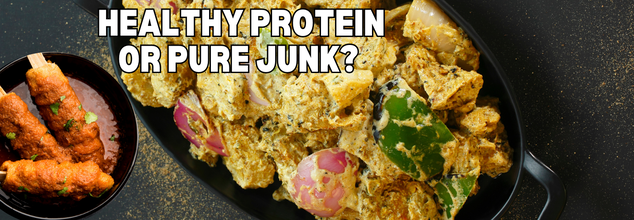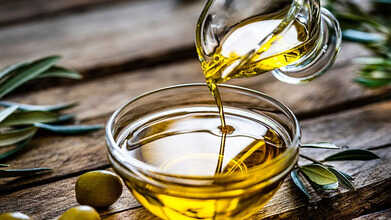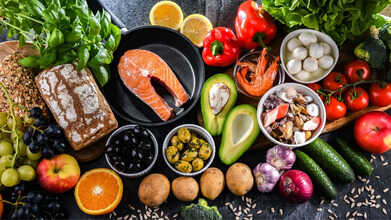- Health Conditions A-Z
- Health & Wellness
- Nutrition
- Fitness
- Health News
- Ayurveda
- Videos
- Medicine A-Z
- Parenting
- Web Stories
Is Soya Chaap Healthy? The Truth Behind This Popular Vegetarian Meat Substitute

Soya chaap, widely known for its chewy texture and meat-like appearance, has become a favorite among vegetarians in India, particularly in the Northern states. Often used as a substitute for chicken in dishes like tandoori soya chaap, this vegetarian staple is made from soy protein and wheat gluten, and shaped into skewers to mimic the appearance of meat.
While it’s marketed as a healthy, protein-rich alternative to meat, the truth about soya chaap might make you rethink adding it to your regular diet.
Soya chaap’s popularity has surged because of its versatility in cooking and its fibrous, meat-like texture that blends seamlessly into a variety of Indian gravies and snacks. However, nutrition experts have raised concerns about its nutritional content and the way it is processed, particularly when compared to whole soy products like tofu or tempeh.
What Exactly Is Soya Chaap?
Soya chaap is made from a combination of soy flour, wheat gluten, and often all-purpose flour (maida). These ingredients are mixed together and processed into a dough that is then shaped into skewers. The final product is a chewy, meat-like substance that can be grilled, fried, or cooked in curries.
Soy itself is one of the few plant-based foods considered a complete protein, meaning it contains all the essential amino acids that the body needs. In its unprocessed form, soybeans offer a variety of health benefits, including being high in protein, fiber, and essential micronutrients.
However, once processed into products like soya chaap, much of these benefits are diminished.
Many commercially available soya chaap products include significant amounts of wheat gluten and refined flour (maida), which, while giving it its desirable texture, can also lower its nutritional value. Maida, a highly refined flour, has been associated with blood sugar spikes and weight gain when consumed in excess.
Additionally, packaged soya chaap often contains preservatives and additives to extend its shelf life and improve flavor, further diminishing its health benefits.
Reality Behind Processed Soya Chaap
During a recent episode of Gut Feeling with Dr. Pal, nutritionist Sangeetha Aiyer discussed the health implications of eating processed soy products like soya chaap. Aiyer, speaking to Dr. Pal Manickam, a leading expert in digestive health, provided a reality check for those who believe soya chaap is a healthy, high-protein food.
Aiyer explained, “It is a lot of vegetable oil mixed with maida, so it is junk. It’s completely ultra-processed, and a lot of vegetarians eat it thinking they’re getting a high-protein option like tandoori chicken. That form of soy is avoidable.”
Dr. Pal also emphasized that while unprocessed soy is indeed a nutritious plant-based protein, processed soy products, including soya chaap and soy chunks, lose much of their nutritional value during processing. Unlike whole soy foods such as tofu and tempeh, soya chaap is often loaded with unnecessary additives that make it a less healthy choice.
How Soya Chaap Compares to Chicken
Soya chaap is often considered the vegetarian equivalent of chicken due to its fibrous texture, which closely mimics meat. It is commonly cooked in the same way as chicken, grilled on skewers, or simmered in spicy gravies. While it may taste similar to chicken and provide a meat-like experience for vegetarians, the two differ significantly in their nutritional content.
Chicken is widely known for its high protein content and low fat levels, especially when consumed skinless. It is packed with essential amino acids, vitamins, and minerals, making it a staple in many balanced diets.
Soya chaap, on the other hand, contains significantly less protein per serving, especially if it's made with a large proportion of maida.
The texture of soya chaap is achieved by the inclusion of wheat gluten and maida, which have little to no nutritional benefits. While soy itself is gluten-free, the gluten in soya chaap adds to its chewiness, misleading consumers into believing they are eating a protein-rich food.
Nutritionist Richa Gangani further highlighted this in a video shared on her Instagram account. “Soya chaap is one dish vegetarians are obsessed with, other than paneer – thinking it is full of protein and super tasty to eat,” she said. However, she noted that many soya chaap products are primarily made of maida, with only about 40% soy flour. “It includes 60% maida, 40% soya flour, salt, and water to give the chaap a stretchy texture,” she added, warning against its daily consumption.
Should Soya Chaap Be a Regular Part of Your Diet?
While it’s clear that soya chaap is not the protein-packed superfood that many believe it to be, this doesn’t mean it has to be eliminated from your diet entirely. Like many processed foods, it can be enjoyed in moderation as part of a balanced diet. Occasional consumption of soya chaap can still provide a tasty alternative to meat, especially when paired with nutrient-rich sides like vegetables and whole grains.
However, it’s important to recognize that soya chaap should not be relied on as a daily source of protein. Instead, nutrition experts recommend opting for less processed soy products like tofu, tempeh, or edamame, which retain the health benefits of soy without the addition of unhealthy fillers and preservatives.
Sangeetha Aiyer recommends mixing tofu and paneer for those looking for a healthier vegetarian protein source. “For some people, I recommend a paneer-tofu mix so they balance each other. You can cut down on the fat content of paneer and raise the protein intake with tofu,” she says.
While soya chaap may be a flavorful and convenient addition to vegetarian meals, it is not the health food that it’s often made out to be. Processed soy products like soya chaap contain added maida, gluten, and preservatives that lower its nutritional value, making it an occasional treat rather than a staple of a healthy diet. For those seeking a more nutritious soy option, unprocessed products like tofu and tempeh are better choices that provide higher protein content without the unnecessary additives.
MCT Oil Explained: Benefits, How To Use It, And Why It’s Gaining Popularity

Credits: Canva
MCT oil has become a popular supplement in the world of health and wellness, often praised for its ability to boost energy, support weight management, and improve brain function. Derived from medium-chain triglycerides, fats that are more easily digested and converted into energy than long-chain fats.
Whether you are an athlete, someone looking to support cognitive health, or simply exploring healthier fat options, understanding what MCT oil is, how to use it, and why it has gained so much attention can help you decide if it belongs in your daily routine.
What Is MCT Oil?Medium-chain triglyceride (MCT) oil is a processed oil typically derived from coconut or palm kernel oil, though small amounts of MCTs are also naturally present in foods like dairy. As the name suggests, MCT oil contains medium-length chains of fats called triglycerides. Because these fatty acids are shorter than the long-chain fats found in many other foods, the body can digest and convert them into energy more quickly.
There are four main types of medium-chain fatty acids: lauric acid, caproic acid, caprylic acid, and capric acid. MCT oil is made up almost entirely of caprylic and capric acids, which are thought to be the most easily absorbed and metabolised by the body.
MCT oil is versatile and easy to add to your daily routine, but it’s best to start small to see how your body responds. Begin with 1 teaspoon a day and gradually increase to 1–2 tablespoons if tolerated. Here are some simple ways to use it:
- In your morning coffee or tea: Blend it in for a creamy texture and sustained energy.
- Smoothies and shakes: Add a spoonful for an extra boost of healthy fats.
- Salad dressings or sauces: Use it as a light base or mix with olive oil.
- Cooking: MCT oil has a low smoke point, so it’s best for drizzling over foods rather than frying or high-heat cooking.
Why Is MCT Oil Getting So Popular?
MCT oil has surged in popularity because of its reputation as a quick and efficient source of energy and its potential health benefits. Unlike longer-chain fats, MCTs are rapidly absorbed by the body and converted into fuel, making them a favorite among athletes, busy professionals, and anyone looking for an energy boost.Additionally, studies suggest that MCT oil may support weight management, improve mental clarity, and even aid digestion. It is is easy to add to coffee, smoothies, or salad dressings which also makes it an attractive option for those seeking a simple way to incorporate healthy fats into their diet.
MCT Oil: Benefits
Research suggests MCT oil may support weight management, improve cognitive function, and provide a quick source of energy since it is metabolized faster than other fats. Some studies also point to its role in reducing risk factors for heart disease and aiding people with digestive issues who struggle to absorb fats. For example, a 16-week clinical trial published in the American Journal of Clinical Nutrition found that participants using MCT oil lost more body weight compared to those using olive oil.While MCT oil is not a magic fix, it can be a useful addition to a balanced diet when taken in moderation. Its potential benefits for energy, metabolism, and brain health make it popular among health enthusiasts, but it is important to consult a doctor before making it a regular part of your routine. Choosing high-quality MCT oil and using it wisely can help you enjoy its advantages without unwanted side effects.
Mediterranean Diet Could Lower Alzheimer’s Risk by 35%, Study Finds: How It Supports Brain Health

Credits: Canva
Taking care of our brains should be a top health priority. After all, the brain controls nearly every function in our body. As we age, however, our brain function naturally declines, and the risk of dementia rises. Dementia is a term that covers memory loss and other cognitive difficulties that significantly affect daily life. Current data suggest that the number of dementia cases—now around 514,000 per year, could double by 2060, highlighting the urgent need for ways to protect the brain.
Research shows that lifestyle choices have a major impact on brain health. But did you know that certain diets can help lower your risk of Alzheimer’s? Here’s what you need to know.
What is Mediterranean Diet?
The Mediterranean diet is a plant-focused way of eating, inspired by the traditional diets of Mediterranean countries. It emphasizes fresh fruits and vegetables, whole grains, legumes, nuts, seeds, and olive oil as the main source of fat. The diet includes moderate amounts of fish and dairy while limiting red meat and sweets. Beyond what’s on the plate, it also encourages lifestyle habits such as regular physical activity and sharing meals with others, which supports social connections and helps reduce stress.Mediterranean Diet Could Lower Alzheimer’s Risk by 35%
A long-term study conducted by the Nurses’ Health Study (NHS), which followed female nurses from 1989 to 2023, found that people who closely followed the Mediterranean diet over the years had a significantly lower risk of dementia and better cognitive function. This protective effect was particularly evident in individuals with varying genetic risk for Alzheimer’s, including carriers of the APOE-e4 gene. Similar findings were also observed in the male Health Professionals Study.ALSO READ: Diet For Mental Health: How Keto Helps With Depression
While the Mediterranean diet as a whole was linked to reduced dementia risk, researchers highlighted a few key components that seem to have the most impact: fresh fruits, nuts, and sources of monounsaturated fats, such as olive oil and avocados.
The study indicates that sticking to the Mediterranean diet over the long term may substantially lower the risk of Alzheimer’s, even for those with a genetic predisposition. This diet is packed with fiber, antioxidants, healthy fats, and lean proteins, found in foods like fruits, vegetables, nuts, seeds, legumes, whole grains, seafood, and olive oil. Incorporating more of these foods into your daily meals can be a simple way to support brain health.
How To Follow a Mediterranean Diet?Incorporating the Mediterranean diet into your daily routine doesn’t have to be complicated. Start by adding more fresh fruits and vegetables to every meal, swapping refined grains for whole grains, and including nuts, seeds, and legumes as snacks or salad toppings. Use olive oil as your main cooking fat instead of butter or processed oils, and aim to include fish or seafood a few times a week.
ALSO READ: Never Eat Chia Seeds THIS Way: Doctor Warns Of Hidden Dangers
Red meat and sweets can be enjoyed occasionally, rather than daily. Beyond food, try to stay active through walking, yoga, or other forms of exercise, and make mealtimes a social experience whenever possible, sharing meals with family or friends to combine nutrition with connection and reduced stress.
For personalised guidance, consulting a registered dietitian can help you create a plan that fits your tastes and lifestyle.
Common Sugary Drinks Can Increase The Risk Of Colorectal Cancer: Study Reveals A Direct Link To Advancement Of The Cancer

(Credit-Canva)
Sugary drinks have always been a big part of the processed food industry. Drinks like sweet sodas and sweet milks are always on the shelf, making it easier for people to indulge in them. However, a new study has highlighted that they have been directly linked to colorectal cancer.
A new study from the University of Texas MD Anderson Cancer Center has revealed a concerning link between the sugar in popular drinks and advanced colorectal cancer. Researchers found that the common mix of glucose and fructose in these beverages might directly speed up the spread of the disease. This is a very important discovery, especially since these same sugary drinks are often recommended for cancer patients to help them with nutrition.
The study shows that what we eat plays a crucial part not just in whether we get cancer, but also in how the disease acts once it has developed.
Over the years studies have shown that things like processed foods can be linked to affecting our health, but could this study lead us to finding a better way to treat and preventing cancer?
How Sugar Makes Cancer More Dangerous
In their research, the scientists created lab models to test different types of sugar on cancer cells. They looked at glucose alone, fructose alone, and a mix of the two—the kind you find in many sodas and juices. What they discovered was surprising: only the glucose-fructose mix made the cancer cells much more active and able to move. This increased movement led to a faster spread of tumors, particularly to the liver, which is the most common place for this cancer to metastasize (spread).
The study also pinpointed the exact way this happens. The sugar mix turns on an enzyme in the body called sorbitol dehydrogenase (SORD). This enzyme then helps the cancer cells get more energy from sugar and also activates a pathway related to cholesterol. This cholesterol pathway is already known to be involved in cancer spreading throughout the body.
Can You Slow Down The Growth of Cancer?
The researchers made another promising finding. They showed that they could slow down the cancer's spread by blocking the SORD enzyme. This worked even when the cancer cells were exposed to sugary drinks. This discovery opens the door for new medicines that could be designed to target and stop this specific process.
The study also suggests a new use for drugs that are already on the market. Statins, which many people take to lower their cholesterol, work by blocking the same pathway that the SORD enzyme activates. This raises an exciting possibility: these common cholesterol drugs might be able to help doctors manage and treat colorectal cancer.
These findings build on earlier research from the same lab that showed even a small amount of sugary drinks can help tumors grow, and this happens even in people who aren't obese. Because of these results, the researchers are now suggesting that doctors and nutritionists should rethink their current advice about giving sugary drinks to cancer patients, especially those with advanced disease.
© 2024 Bennett, Coleman & Company Limited

